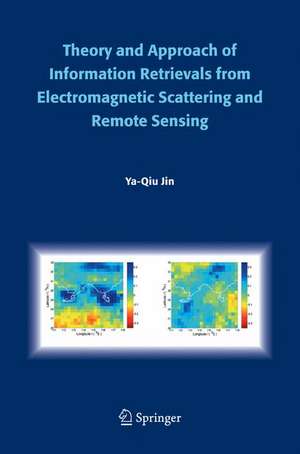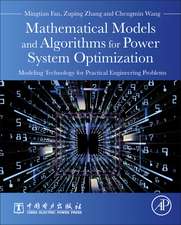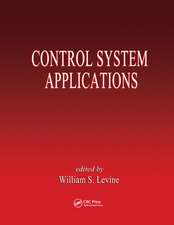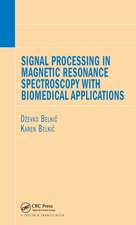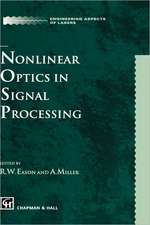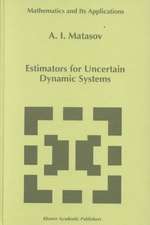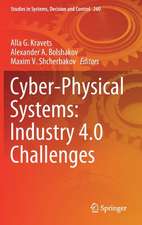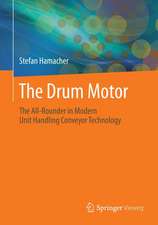Theory and Approach of Information Retrievals from Electromagnetic Scattering and Remote Sensing
Autor Ya-Qiu Jinen Limba Engleză Hardback – 8 dec 2005
| Toate formatele și edițiile | Preț | Express |
|---|---|---|
| Paperback (1) | 949.23 lei 6-8 săpt. | |
| SPRINGER NETHERLANDS – 23 aug 2016 | 949.23 lei 6-8 săpt. | |
| Hardback (1) | 958.38 lei 6-8 săpt. | |
| SPRINGER NETHERLANDS – 8 dec 2005 | 958.38 lei 6-8 săpt. |
Preț: 958.38 lei
Preț vechi: 1168.76 lei
-18% Nou
Puncte Express: 1438
Preț estimativ în valută:
183.38€ • 191.98$ • 151.74£
183.38€ • 191.98$ • 151.74£
Carte tipărită la comandă
Livrare economică 05-19 aprilie
Preluare comenzi: 021 569.72.76
Specificații
ISBN-13: 9781402040290
ISBN-10: 1402040296
Pagini: 394
Ilustrații: X, 386 p.
Dimensiuni: 155 x 235 x 19 mm
Greutate: 0.82 kg
Ediția:2006
Editura: SPRINGER NETHERLANDS
Colecția Springer
Locul publicării:Dordrecht, Netherlands
ISBN-10: 1402040296
Pagini: 394
Ilustrații: X, 386 p.
Dimensiuni: 155 x 235 x 19 mm
Greutate: 0.82 kg
Ediția:2006
Editura: SPRINGER NETHERLANDS
Colecția Springer
Locul publicării:Dordrecht, Netherlands
Public țintă
ResearchCuprins
Vector Radiative Transfer (VRT) Theory of Inhomogeneous Random Media.- Fully Polarimetric Scattering of Non-Spherical Scatter Media.- SAR Imagery and Applications.- Remote Sensing Data Validation and Applications.- Numerical Forward-Backward Method (FBM) for Scattering from Randomly Rough Surface and Target.- Numerical Finite Element Method (FEM) for Scattering from Randomly Rough Surface and Target.- Inverse Scattering and Parameter Retrievals.- Electromagnetics of Complex Particulate Media.
Notă biografică
Ya-Qiu Jin received the B.S. degree from Peking University (1970), and the M.S. (1982), E.E. (1983) and Ph.D. (1985) degrees from the Department of Electrical engineering and Computer Science, Massachusetts Institute of Technology, USA.
He was a Research Scientist at the Atmospheric and Environmental Research Inc. in Cambridge, USA (1985), Research Associate at the City University of New York (1986-1987), Visiting Professor at the University of York, UK (1993-94) sponsored by the UK Royal Society and at the City University of Hong Kong (2001). He held the Senior Research Associateship at NOAA/NESDIS awarded by the USA National Research Council (1996).
He is full Professor in the School of Information Science and Engineering, and Director of the Key Laboratory of Wave Scattering and Remote Sensing Information (Ministry of Education), Fudan University, Shanghai, China. He has been appointed as the Principal Scientist for the China State Major Basic Research Project (2002-2007) by the Ministry of National Science and Technology of China to lead the remote sensing state program in China.
He has been elected as the IEEE Fellow for his contribution of electromagnetic scattering model for remote sensing application. He is the founder and Chairman (1995-2003) of IEEE GRSS China Chapter.
He has published over 430 papers in China and abroad, and six books (two are in English: Electromagnetic Scattering Modeling for Quantitative Remote Sensing by Singapore: World Scientific (1994), Information of Electromagnetic Scattering and Radiative Transfer in Natural Media by Beijing: Science Press (2000)). He is the Editor of SPIE Volume 3503: Microwave Remote Sensing of the Atmosphere and Environment by USA: SPIE, and the book: Wave Propagation, Scattering and Emission in Complex Media by Singapore: World Scientific and Beijing: Science Press (2004). He is Chairman of ISAPE2000 and the International Specialist Workshop 2004 on EM Scattering and Information Retrieval in Remote Sensing.
His main research interests include electromagnetic (EM) scattering in complex media, microwave remote sensing, and computational EM. He received the China National Science Prize in 1993, the First-grade Science Prizes of the State Education Ministry in 1992, 1996, the teaching excellence Prize of Shanghai City in 2001, the excellent supervisor for graduate students in Fudan University in 2003, and the Fudan President Prize in 2004 among other many prizes.
1
He was a Research Scientist at the Atmospheric and Environmental Research Inc. in Cambridge, USA (1985), Research Associate at the City University of New York (1986-1987), Visiting Professor at the University of York, UK (1993-94) sponsored by the UK Royal Society and at the City University of Hong Kong (2001). He held the Senior Research Associateship at NOAA/NESDIS awarded by the USA National Research Council (1996).
He is full Professor in the School of Information Science and Engineering, and Director of the Key Laboratory of Wave Scattering and Remote Sensing Information (Ministry of Education), Fudan University, Shanghai, China. He has been appointed as the Principal Scientist for the China State Major Basic Research Project (2002-2007) by the Ministry of National Science and Technology of China to lead the remote sensing state program in China.
He has been elected as the IEEE Fellow for his contribution of electromagnetic scattering model for remote sensing application. He is the founder and Chairman (1995-2003) of IEEE GRSS China Chapter.
He has published over 430 papers in China and abroad, and six books (two are in English: Electromagnetic Scattering Modeling for Quantitative Remote Sensing by Singapore: World Scientific (1994), Information of Electromagnetic Scattering and Radiative Transfer in Natural Media by Beijing: Science Press (2000)). He is the Editor of SPIE Volume 3503: Microwave Remote Sensing of the Atmosphere and Environment by USA: SPIE, and the book: Wave Propagation, Scattering and Emission in Complex Media by Singapore: World Scientific and Beijing: Science Press (2004). He is Chairman of ISAPE2000 and the International Specialist Workshop 2004 on EM Scattering and Information Retrieval in Remote Sensing.
His main research interests include electromagnetic (EM) scattering in complex media, microwave remote sensing, and computational EM. He received the China National Science Prize in 1993, the First-grade Science Prizes of the State Education Ministry in 1992, 1996, the teaching excellence Prize of Shanghai City in 2001, the excellent supervisor for graduate students in Fudan University in 2003, and the Fudan President Prize in 2004 among other many prizes.
1
Caracteristici
Covers several hot topics in current research of electromagnetic scattering, and radiative transfer in complex and random media, polarimetric scattering and SAR imagery technology, data validation and information retrieval from space-borne remote sensing, computational electromagnetics, etc. Including both forward modelling and inverse problems, analytic theory and numerical approaches An overall summary of the author’s works during most recent years Also presents some insight for future research topics
